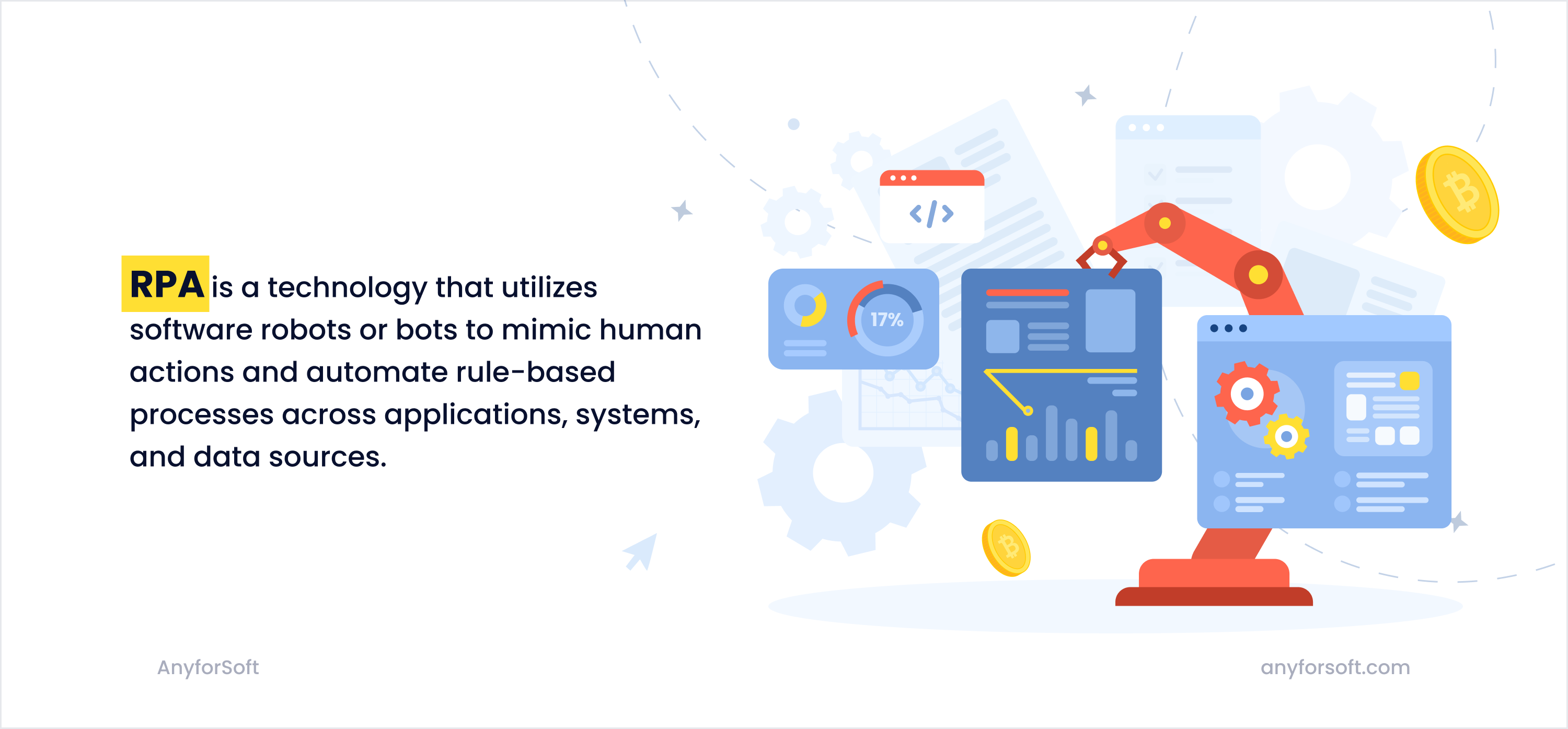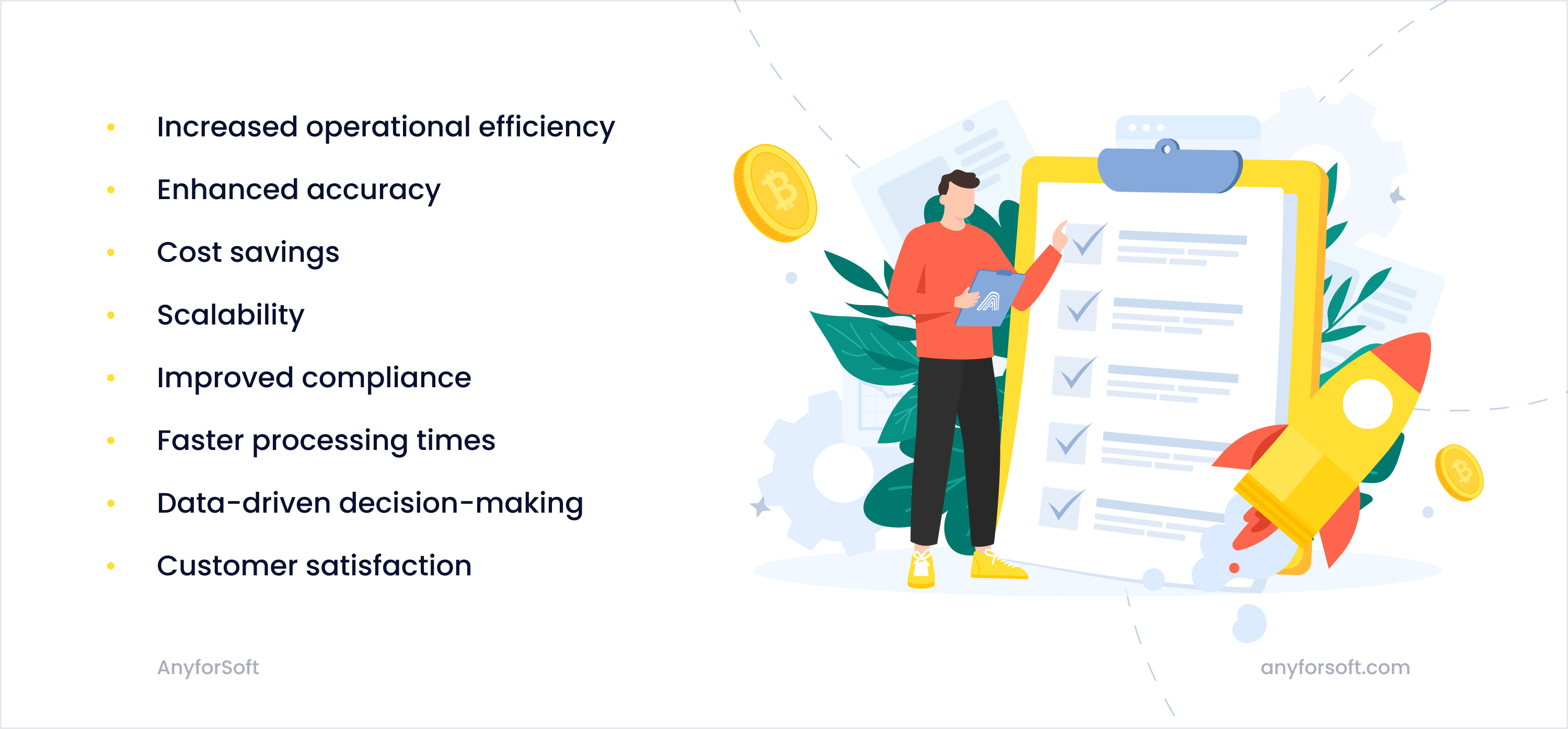Robotic process automation (RPA) is probably one of the most exciting technologies. Initially, RPA solutions were used in the manufacturing industry to assemble automobiles, household appliances, furniture, and other complex products. But nowadays they have begun infiltrating the back office as well.
By implementing RPA software, businesses automate manual labor-intensive processes, minimize errors associated with the human factor, save costs, increase operational efficiency, and improve security. No wonder more and more organizations start investing in this technology.
As an experienced fintech software development company, AnyforSoft would like to discuss RPA in finance in more detail. In this article, we dive deep into the topic, covering the following questions:
- What is RPA in finance?
- How are modern businesses using robotic process automation?
- What are the benefits of RPA?
- What are the challenges of implementing RPA in finance and accounting?
If you plan to implement RPA tools into your own business, don’t skip this blog post!
What is RPA in Finance?

The first question we should cover is, what is robotic process automation?
In short, robotic process automation is a technology that utilizes software robots or bots to mimic human actions and automate rule-based processes across applications, systems, and data sources. Just like humans, RPA bots are able to perform many actions, such as completing the right keystrokes, navigating systems, identifying and extracting data, and so on. However, they do it faster and more consistently than people, without coffee and smoke breaks.
In the financial industry, RPA has the potential to optimize business processes and improve operational efficiency. By automating mundane and repetitive tasks, it enables finance teams to reallocate their time and resources to more important activities, such as financial analysis, decision-making, and customer service.
RPA typically goes hand in hand with artificial intelligence and machine learning. These technologies boost the power of robotic process automation in many ways. More specifically, ML and AI algorithms:
- Prevent RPA robots from encountering errors when underlying rules change.
- Find patterns in historical data to identify the most relevant information for decision-making.
- Analyze data and predict outcomes that help organizations make well-informed decisions.
Let’s make it clearer with an example. Say, you’re using RPA software to consolidate data from various sources about customer payments scheduled to come in, along with invoices that will need to be paid. Machine learning can predict the likelihood that each customer will make their payment on time. Thus, you will be able to use these predictions to make informed decisions and take appropriate actions in the following areas:
- Reducing administrative costs. By accurately predicting which customers are likely to make timely payments, you will be able to focus your company’s resources and efforts on following up with those customers who may face payment issues. This targeted approach will lead to reduced administrative costs related to collections and accounts receivable management.
- Extending supplier payment terms. If a business can predict that certain customers are highly likely to make their payments on time, it may have more confidence in its cash flow. This increased financial stability enables the company to negotiate longer payment terms with suppliers, improving its working capital position.
- Investing in new equipment. Reliable predictions about customer payment behavior help you better assess your financial position and cash reserves. With the assurance of timely payments from certain customers, your business has the confidence to invest in new equipment or expansion initiatives, potentially leading to business growth and increased efficiency.
By the way, we have a comprehensive blog post explaining the benefits of AI in fintech—make sure to check it to learn more about how artificial intelligence helps organizations in the financial sector.
Use Cases of RPA in Finance
Now that you know what robotic process automation is, let’s take a look at how modern businesses are using the technology. Here are 12 RPA use cases in finance and accounting.
#1 Accounts payable and receivable automation
RPA applications in finance are deployed to automate invoice processing, payment reconciliations, and data entry tasks related to accounts payable and accounts receivable. With their help, organizations streamline their payment processes, reduce manual errors, and accelerate invoice processing times.
#2 Finаncial reporting and compliance
Financial reporting and compliance is quite a hassle, especially for finance managers. They spend a lot of time gathering and consolidating data from different sources, which is tedious and time-consuming. With robotic process automation, however, their routine gets much easier. By investing in RPA, organizations are able to streamline their financial reporting, data aggregation, and regulatory compliance tasks. This allows them to get things done much faster, ensuring that reports are accurate and submitted on time.
#3 Financial data entry and validation
Data entry tasks are boring and prone to human errors, especially when it comes to numbers. A single mistake can lead to significant expenses, so it is much more prudent to leave data entry and validation routine to bots. RPA completely automates the data entry for financial transactions like payroll and journal entries. With this tech at work, financial companies can be confident in the accuracy of their records and save valuable time that would be otherwise spent on tedious work.
#4 Managing expenses
Robotic process automation in finance and accounting is a game-changer when it comes to managing expenses. More specifically, RPA bots take care of creating, validating, and processing expense reports, which means less paperwork for finance teams and quicker reimbursements for employees. With this technology at hand, you will be able to focus on really important tasks instead of spending valuable time on monotonous work.
#5 Bank reconciliation
Bank reconciliation is when you compare the balances of your organization's financial reports for a cash account to the related details on a bank statement. This process is aimed to determine the discrepancies between the two and, if necessary, make changes to the accounting records. To ensure that your company's records are accurate, you should regularly go through bank reconciliation. Otherwise, cash balances might be significantly smaller than predicted, which will result in bounced checks or overdraft fees. With RPA, you can fully automate the bank reconciliation process and thus make it less prone to errors.
#6 Financial Planning and Analysis (FP&A)
Projecting short- and long-term financial strategies takes a lot of preparation and research. FP&A software uses existing financial data to automatically create budget models. This allows experts to visualize and experiment with an unlimited range of scenarios while completely eliminating the risk of human error. RPA bots automate budgeting, forecasting, and variance analysis, allowing finance experts to focus their attention on strategic planning and providing top-notch insights to the management team.
#7 Customer onboarding and KYC processes
Another use case of robotic process automation for finance is customer onboarding and Know Your Customer (KYC) processes. It accelerates these tasks, helping you focus on more important matters. RPA helps financial institutions speed up the verification of customer data, ensuring a smoother onboarding experience and happier clients.
#8 Mortgage processing
In the banking and lending sector, deploying RPA also proves to be highly useful. More specifically, RPA bots accelerate mortgage processing by automating tasks like document verification, credit checks, and underwriting processes. It helps organizations cut down on waiting times for loan approvals so that their customers are able to receive financial help way faster.
#9 Tax and audit support
Managing taxes and audits is quite challenging, but RPA lends a helping hand. It gathers and analyzes data for tax compliance, making tax preparation a breeze. Plus, it gives auditors real-time access to financial records and documents, allowing financial institutions to breathe a little easier during audits.
#10 Fraud detection
Protecting customers and businesses from fraud is crucial, and RPA with AI and machine learning is exactly what organizations need. RPA bots are always on the lookout for suspicious activities and help companies catch potential fraud in real-time, safeguarding their finances and reputation.
#11 Financial forecasting and market analysis
RPA gathers market data, performs data analysis, and generates financial forecasts based on predefined algorithms and models. This allows finance professionals to make data-driven decisions instead of relying on guesswork.
#12 Automated account closure
With thousands of customers opening and managing their accounts daily, banks and other financial institutions receive plenty of account closure requests every month. Besides, an account must be closed when a customer fails to submit mandatory documents or comply with the organization’s terms of service. Robotic process automation in finance helps organizations identify and track such accounts and timely close them.
RPA for Finance: Advantages of the Technology

As you’ve just learned, robotic process automation has plenty of use cases. And this should come as no surprise considering how many advantages RPA implementation brings to businesses. Here are the main benefits of RPA in finance:
- Increased operational efficiency. RPA minimizes the need for manual labor in repetitive tasks, leading to improved efficiency and reduced operational costs. This allows finance professionals to focus on more strategic activities that require human expertise rather than wasting valuable time on dull and tedious work.
- Enhanced accuracy. Human errors are inevitable when it comes to manual processes. With the RPA in the finance industry, however, companies perform tasks with precision and consistency. It results in higher accuracy and reduced chances of errors in financial data.
- Cost savings. Even though the implementation of robotic process automation is quite expensive, organizations win in the long run. By automating tasks, optimizing resource allocation, and reducing the need for manual work, they achieve significant cost savings. So don’t hesitate to invest in finance automation solutions.
- Scalability. RPA handles multiple tasks simultaneously. Therefore, you can scale your organization and thus the volume of finance tasks it handles without a second thought.
- Improved compliance. RPA ensures adherence to regulatory requirements and compliance standards by automating processes in a consistent and auditable manner. Faster processing times. RPA performs tasks at a much faster pace than humans, resulting in reduced processing times and faster response to customer queries.
- Data-driven decision-making. By automating data collection and analysis, RPA solutions provide finance professionals with real-time insights and facilitate data-driven decision-making.
- Customer satisfaction. With faster and more accurate financial processes, organizations enhance customer experience, leading to higher customer satisfaction and loyalty.
Challenges of Implementing RPA in Finance
While RPA offers a myriad of enticing benefits, its successful implementation in corporate finance and other industries comes with challenges that you should be aware of. Here are the most common ones:
- Integration complexity. Integrating RPA with existing legacy systems and applications may be complex and require careful planning and expertise.
- Data security and privacy. Automation solutions involve handling sensitive financial data, so ensuring proper data security and privacy is imperative. Organizations must implement robust security measures to protect against potential cyber threats.
- Change management. RPA implementation usually comes with changes in existing workflows and processes, which employees might not like. Thus, every company should adopt adequate change management strategies before introducing the technology.
- Maintenance and monitoring. Regular maintenance and monitoring of RPA bots are essential to ensure their optimal performance and identify any issues promptly.
- Process standardization. RPA works best when processes are standardized. Therefore, organizations should reevaluate and streamline their existing processes before embracing the technology.
However, you shouldn’t worry. Professional software development companies are aware of the mentioned challenges and know how to address them in the most efficient and cost-effective manner.
Conclusion
RPA and finance go hand in hand. When it comes to banks, financial institutions, mortgage lenders, and other organizations, robotic process automation is a great tool that increases operational efficiency, improves accuracy, leads to cost savings, and offers plenty of other benefits.
Yes, implementing robotic process automation is expensive and time-consuming, but by doing it you win in the long run.
81% of companies are already investing in robotic process automation technology to achieve their financial saving goals.
Don’t let them get ahead of you.
Invest in custom RPA development today and stand out from the competition.
AnyforSoft is a customer-oriented company that creates software products with the client’s vision and requirements in mind. Over 12 years of experience allows us to create solutions of any complexity. Contact us today and tell us about your project so that we can build a unique tool that will help your business prosper.
